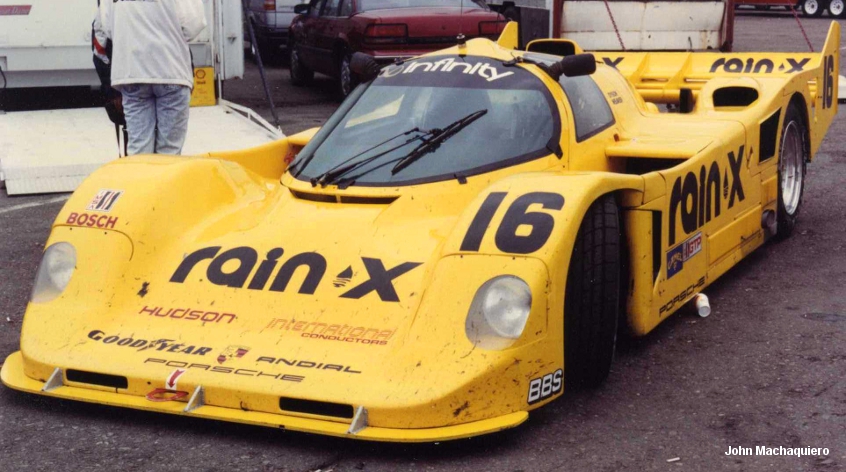
Images copyright Michael J. Fuller, John Machaqueiro, and Martin Spetz
Text copyright Michael J. Fuller

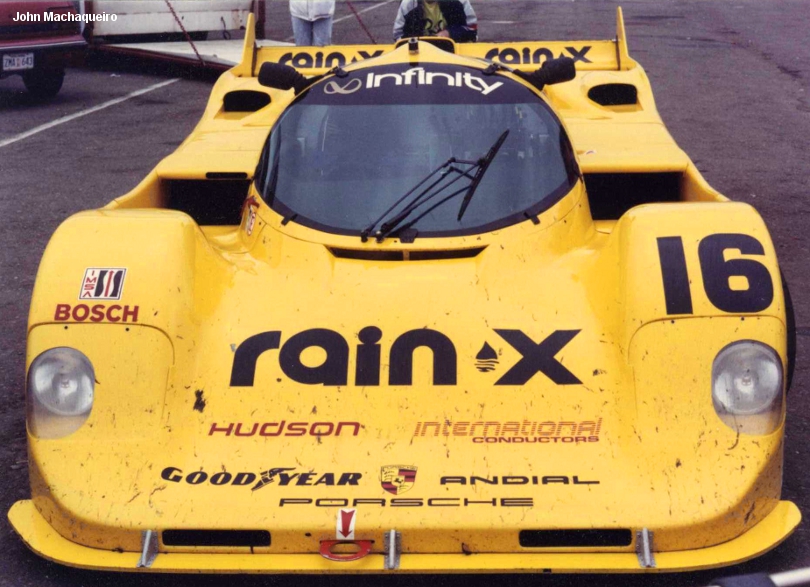 Designed
by Art Center graduate Richard Yagami, and powered by Porsche's 3.2
liter,
twin turbo, water cooled, flat-six, the DR2 was a substantial reworking
of a racing legend. Yagami joined Dyson after leaving
Nissan Performance Technology, Inc., where he had been heavily involved
with the aerodynamics development of Nissan's new NPT-90 chassis, and
the 962DR2 certainly shows that influence. Designed
by Art Center graduate Richard Yagami, and powered by Porsche's 3.2
liter,
twin turbo, water cooled, flat-six, the DR2 was a substantial reworking
of a racing legend. Yagami joined Dyson after leaving
Nissan Performance Technology, Inc., where he had been heavily involved
with the aerodynamics development of Nissan's new NPT-90 chassis, and
the 962DR2 certainly shows that influence.Yagami eliminated the Porsche factory funnel nose inlet and instead brought a revised, decidedly wedge-shaped, nose to a splitter. The horizontal surface heading the splitter certainly acted to produce an amount of useful downforce as that was one of the primary complaints of GTP cars of the era; a lack of front downforce. The two turbo inlets can be seen over the rear wheel arches. Note the small slit inlet in the leading edge of the primary cooling duct on the car's right hand side. This provided cooling air to the cockpit. |
 The
DR2's tub was fabricated by Dave Klym's Fabcar,
then located in Atlanta (they have since moved to
Indianapolis).
According to Klym, the DR2's tub differed from the factory's in that it
was manufactured out of aluminum honeycomb sandwiched between aluminum
sheet (as opposed to just aluminum sheet) with machined billet front and
rear
bulkheads. The Fabcar DR2 tub had a 1" thick honeycomb spine
running
from front to back, replacing the standard sheet aluminum
piece.
Klym
cites that the DR2 tub was between 6 and 8 times stiffer than the
Porsche
factory tub. The
DR2's tub was fabricated by Dave Klym's Fabcar,
then located in Atlanta (they have since moved to
Indianapolis).
According to Klym, the DR2's tub differed from the factory's in that it
was manufactured out of aluminum honeycomb sandwiched between aluminum
sheet (as opposed to just aluminum sheet) with machined billet front and
rear
bulkheads. The Fabcar DR2 tub had a 1" thick honeycomb spine
running
from front to back, replacing the standard sheet aluminum
piece.
Klym
cites that the DR2 tub was between 6 and 8 times stiffer than the
Porsche
factory tub. Other areas of the car were stiffened as well. According to former Dyson Team Manager Mark Schomann, it had been observed that the bodywork around the cockpit on the standard 962 would flex, cracking the paint, indicating an overall stiffness issues in the interface between tub and bodywork. To counter this the side pods and the areas around the radiators were beefed up. An engine subframe was also installed. This resided underneath the engine and connected the rear of the tub with the bellhousing, helping brace the entire engine installation. |
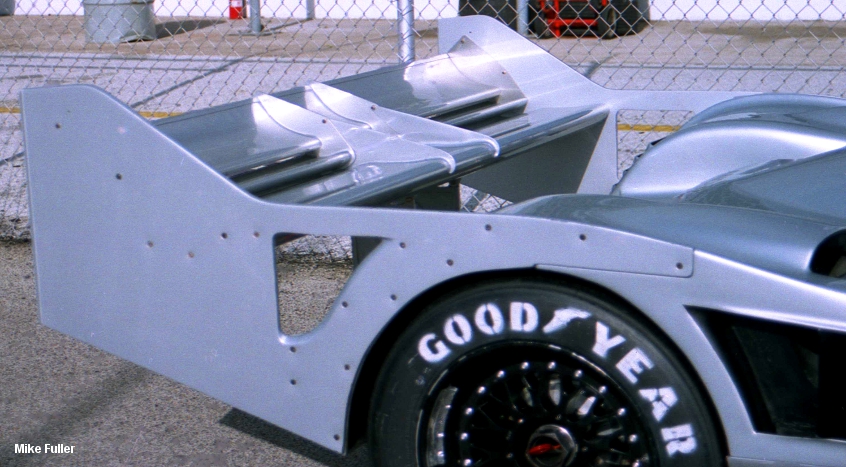 According to Yagami, one of the perceptions about the rear wing setup on
the 962 was that in yaw conditions it was felt that the leading edge of the long integral
endplates
on the standard tail, coupled with the proximity of the low
pressure area created towards the trailing edge of the cockpit teardrop, blocked flow to the outboard portions of the rear
wing. According to Yagami, one of the perceptions about the rear wing setup on
the 962 was that in yaw conditions it was felt that the leading edge of the long integral
endplates
on the standard tail, coupled with the proximity of the low
pressure area created towards the trailing edge of the cockpit teardrop, blocked flow to the outboard portions of the rear
wing.To counter the yaw/endplate affects Yagami first reduced the leading edge shape of the endplate, reducing the side area ahead of the wing. Second, he placed a hole into the end plate ahead of the assembly to allow for more airflow volume to interact with the wing. Additionally, the endplates were made integral to the body based on Dyson's concern with them getting accidentally hit and knocked off during a race. The thinking was with the endplates integral to the body, a rather substantial hit would be required to knock them off. The entire wing assembly was mounted low in order to enhance the interaction with the underfloor. The DR2's triple element rear wing followed the trend established by Nissan and familiar to Yagami through his work there on the NPT-90. Yagami indicated that the DR2's development did not benefit from wind tunnel testing. |
 The
962DR2's underbody was substantially altered from the factory (compare
with the Joest
962C).
The pancake nature of the flat-six and its
packaging
difficulties
is evident here. Efforts were made on the 962DR2 to increase
tunnel volume as much as possible. The execution was left up to
Crawford Composites with Yagami consulting. The
962DR2's underbody was substantially altered from the factory (compare
with the Joest
962C).
The pancake nature of the flat-six and its
packaging
difficulties
is evident here. Efforts were made on the 962DR2 to increase
tunnel volume as much as possible. The execution was left up to
Crawford Composites with Yagami consulting. |
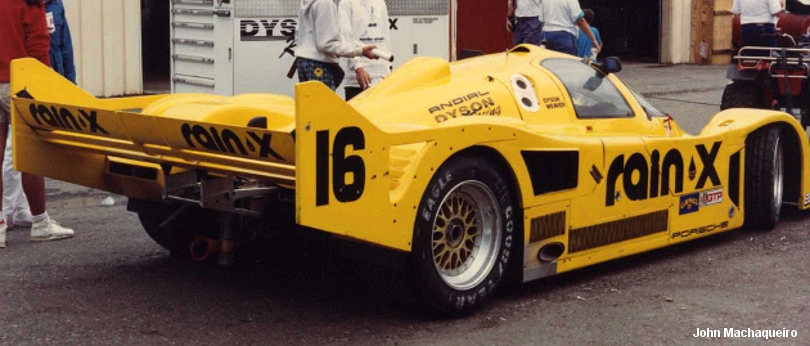 The
broad architectural similarities to the Nissan GTP are evident here
looking primarily at the rear wing. An interesting detail is the
intercooler exhaust exit ahead of the rear wheel, a detail the DR2 also
shares with the Nissan GTP ZX-T. While the shape is different the placement is the same and we can bet on Yoshi Suzuka's influences. The
broad architectural similarities to the Nissan GTP are evident here
looking primarily at the rear wing. An interesting detail is the
intercooler exhaust exit ahead of the rear wheel, a detail the DR2 also
shares with the Nissan GTP ZX-T. While the shape is different the placement is the same and we can bet on Yoshi Suzuka's influences. |
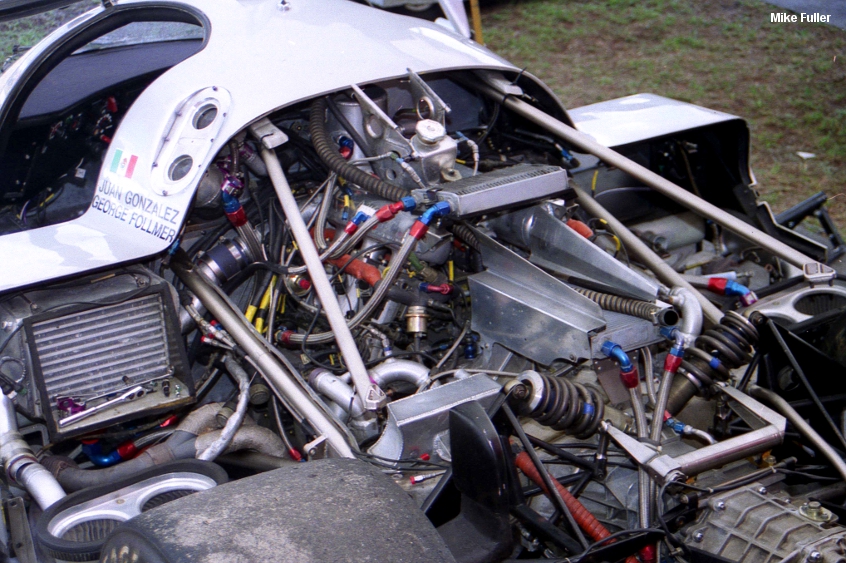 The
DR2's Porsche flat-six was unique for its turbo arrangement. The
turbos were positioned such that the exhaust side (hot side) was
forward and the intake aimed rearwards. Says Schomann, "Swapping the
turbos around gave us the ability to get positive pressure in the
airbox in a smaller and more efficient space." The turbo intakes
were set into the leading edge of the rear fenders (one in each fender)
and plumbed downward and into the airbox proper that resided in the
sidepod, just ahead of each of the rear wheels. The rearward
facing turbos drew air through filters located in the airbox which were
in turn fed via the sculpted intakes residing on top of the rear
fenders. The
DR2's Porsche flat-six was unique for its turbo arrangement. The
turbos were positioned such that the exhaust side (hot side) was
forward and the intake aimed rearwards. Says Schomann, "Swapping the
turbos around gave us the ability to get positive pressure in the
airbox in a smaller and more efficient space." The turbo intakes
were set into the leading edge of the rear fenders (one in each fender)
and plumbed downward and into the airbox proper that resided in the
sidepod, just ahead of each of the rear wheels. The rearward
facing turbos drew air through filters located in the airbox which were
in turn fed via the sculpted intakes residing on top of the rear
fenders.In order to lower the engine cover and to wrap it tighter around the engine the DR2's oil tank was moved forward from the traditional position near the bellhousing, instead being incorporated into the rear bulkhead and engine mount area. The DR2's gearbox and bellhousing were standard Porsche parts. |
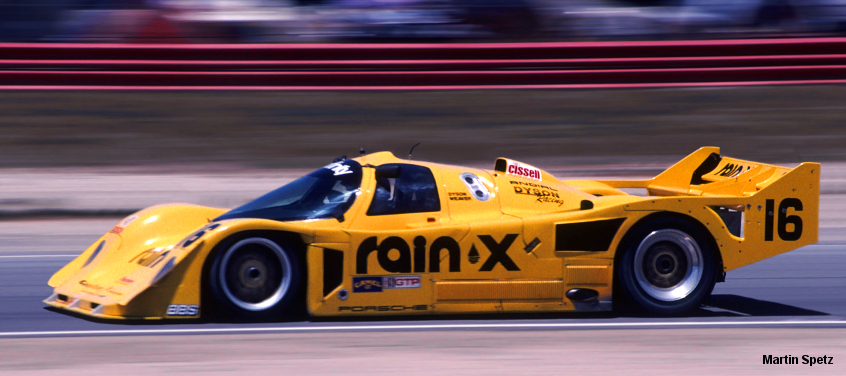 The
definitive DR2 debuted at Watkins Glen, Round 10 (of 14) of the 1991
IMSA
season. Qualifying 10th, the Porsche DNF'd with engine
trouble in
the race. At Laguna Seca, the DR2 qualified 9th and finished
6th.
At Portland, the Dyson DR2 qualified 7th but finished in 14th place,
some
17 laps down. The DR2 finished out the season at Road America
(Round
13) where it again succumbed to mechanical woes again (clutch). The
car
was absent at the Del Mar season finale and it never raced again. The
definitive DR2 debuted at Watkins Glen, Round 10 (of 14) of the 1991
IMSA
season. Qualifying 10th, the Porsche DNF'd with engine
trouble in
the race. At Laguna Seca, the DR2 qualified 9th and finished
6th.
At Portland, the Dyson DR2 qualified 7th but finished in 14th place,
some
17 laps down. The DR2 finished out the season at Road America
(Round
13) where it again succumbed to mechanical woes again (clutch). The
car
was absent at the Del Mar season finale and it never raced again.Was the 962SR2 any good? Mark Schomann has the last word, "Yes it was very good. It made more downforce than any 962 ever made as far as we know. The center of pressure was also more to the front, so it solved the understeer problem that all 962s had." |
